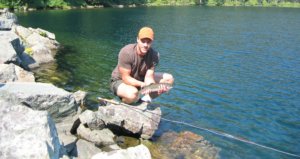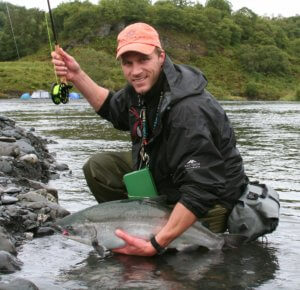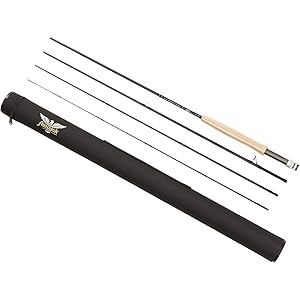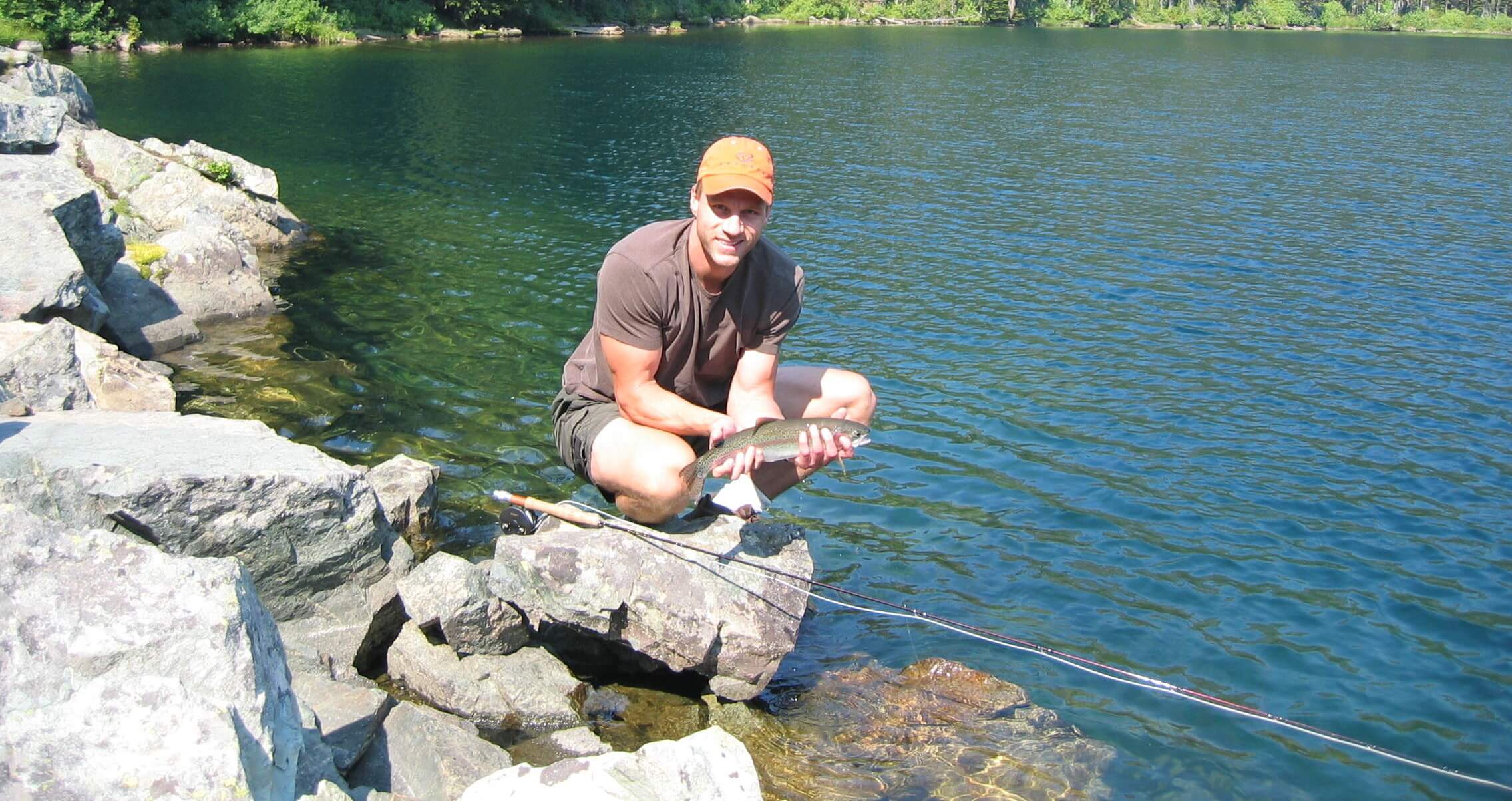If you want to learn how to fly fish for trout, you need a fly fishing rod — but which rod is the best fly rod for trout? Fly rods come in different lengths and “weights” of rods, not to mention a wide range of prices and even cork handle styles. Where does a new fly fisher begin in 2016?
Don’t worry and don’t overthink this — with just a few tips, a good trout rod is easy to find and it’s an easy choice to make.
To start, get a 4-piece rod instead of a 2-piece. Why? Packability. Trust me. It’s worth it.
Next, look for one that is 9 feet long. Why? Versatility. You’ll be able to cast better in more situations and you’re less likely to hook yourself when you’re learning.
Choose a 5-Weight or 6-Weight Fly Rod for Trout

Rods are “sized” by the weight of fly line that will work best for the rod, so pick your rod first and then buy the fly line to match. So which “weights” are best for trout? The best is a 5-weight or 6-weight fly rod, hands down.
Why? A 5-weight or 6-weight line is heavy enough that newbies can learn to cast it in a wide variety of fishing conditions and be successful — but it’s not so heavy that they’ll beat the water into a froth and scare the fish.
If you’ll be fishing for trout on smaller rivers and streams, choose a 5-weight. If you’ll be fishing on larger rivers and streams, choose a 6-weight. If you will be fishing in a place that has a lot of wind, choose a 6-weight. If you’ll be fishing in ponds and lakes with larger trout, either will work great, but I would error toward a 6-weight fly rod so you can cast larger flies more easily (and maybe even go after a bass just for kicks and giggles).
If you’re not sure where you’re going to be fishing most, choose a 5-weight. Why? For the vast majority of trout fishing, you simply can’t go wrong with a 9-foot, 5-weight rod. Especially for your first fly rod. In fact, I’m starting to recommend 5-weight fly rods to nearly all new fly fishers because they are lighter and are easier to cast while beginners are learning to fly fish.
How to Find a Good Fly Fishing Rod for Trout
Some people say that newbies can more easily cast “medium” or “slow” action fly rods. This is hogwash. It used to be a marketing effort to help new customers feel better about buying cheaper rods. Why cheaper? The action of the fly rod is all about its stiffness and where the rod bends. A medium or slow action rod will be very bendy, with a bend that arcs widely across the entire rod. Typically, it used to cost less to build a medium or slow action rod . . . hence the entry level price.
In my experience teaching a range of men, women, and kids, they all were able to learn and control their casts more quickly with a medium-fast action or even a fast-action rod. A medium-fast action has a stiffer butt section and the top half of the rod tends to flex the most. A fast-action rod flexes primarily at the very tip, and they are sometimes referred to as “tip flex” rods. I prefer a faster action rod, but medium-fast is pretty versatile. (Of course, for experts, there is more to how a rod flexes and “loads” that makes up how a rod feels and casts, but again, you can worry about this after you’ve caught some trout and are forever hooked on fly fishing yourself.)
Quality & Cost of Fly Rods for Trout

Stay away from dirt-cheap rods that you can buy at discount department stores. They will be heavy sticks. The flat-out best buy in terms of quality and low cost is the Three Forks line of fly rods at Cabela’s. Hands-down. I landed a 23-inch brown trout on my tiny 3-weight once, and the nearly 20-inch rainbow in the feature photo at the top was also landed with my 3-weight Three Forks rod. In addition, I’ve caught hard-fighting coho salmon on an 8-weight Three Forks rod while fishing with the bears in Alaska. For a rod that you can get for less than $80, this is an amazing deal.
Your next choice leaps up to the $150-200 range. This is a tough range. You get a little better quality, but often you don’t get a 25-year or lifetime warranty that you can get once you break past the $200 price range. You could buy two Three Forks rods, for example, and end up with a backup rod with money to spare on other gear, like a decent set of waders. Why a backup rod? If you stumble and fall and break your rod, you don’t want your fishing trip to end right there.
If you’re just starting out fly fishing, buying a combo that includes a reel, backing, and fly line is usually the best way to go. The Cabela’s Three Forks kits are also excellent entry-level outfits, as is the L.L.Bean Quest II Fly Rod Outfits, but for a step up in quality, I like the Orvis Clearwater Fly Rod Outfit with a 25-year warranty.

If you have the budget to spend $300 or more on your rod or kit, it’s hard to go wrong. Most fly rod companies in the U.S. produce quality rods at this price range and stand behind their work.
After the $200-500 price range, you can get higher quality rods — and hard-core fly fishermen love them. For most people, these rods won’t make them cast better or make them more effective, and most people won’t even be able to notice a difference. In fact, simply wading to a smarter position on a river will usually deliver better results than a fancy rod. Still, I do like owning fine equipment and then taking care of it for years. I have a 9-foot, 6-weight Sage that I received as a gift, and I’ve fished with it for 19 years. Awesome rod. (I even broke it once and Sage repaired it.)
If you have the budget, buy quality. As your skills increase, the rod will perform even better. If you don’t have the budget, invest in decent entry-level gear . . . and when you end up becoming a serious fan, you’ll know exactly what to upgrade into next. In the meantime, here’s some help:
Best Budget Trout Fly Rods & Outfits
- Cabela’s Three Forks Rods — just the rod, great price-to-value ratio
- Cabela’s Three Forks Rod with Prestige Plus Reel Fly Combo
- Orvis Encounter Combo
- L.L.Bean Quest II Fly Rod Outfits — comes with L.L. Bean’s legendary “100% Satisfaction Guarantee”
Excellent Mid-Level Trout Fly Rods & Outfits
- Orvis Clearwater Fly Rod Outfit — 25-year guarantee!
- Cabela’s LSi Fly Rods with Prestige Premier Fly Combo
- Sage Approach Fly Rods
- Fenwick Aetos Fly Rods
Sweet High-End Trout Fly Rods & Outfits
- Hardy Zephrus FWS Fly Rod with Hardy Ultralite MTX Fly Reel
- Orvis Helios 3 Fly Rod with Orvis Mirage Reel
- G.Loomis NRX Lite Presentation Fly Rod with Ross Evolution LTX Fly Reel
Shop fly rods and reels from Fishwest.com and get free shipping on most orders over $89!


